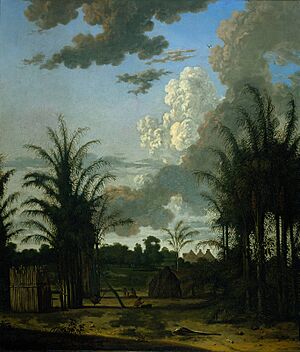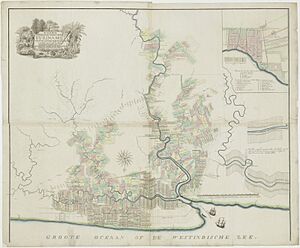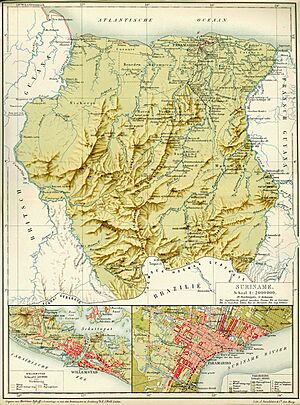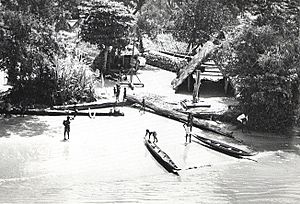History of Suriname facts for kids
The early history of Suriname began around 3000 BCE. This is when Native American people first lived in the area. Later, the Dutch took control of Suriname from the English. Many Europeans started settling there in the 1600s. It became a colony where large farms, called plantations, grew sugar using enslaved people.
When slavery ended in the late 1800s, plantation owners looked for new workers. They brought people from China, Madeira, India, and Indonesia, which was also a Dutch colony. Today, Dutch is Suriname's official language. Because of its many different people, Suriname also has its own creole language called Sranan Tongo.
Contents
Early Native American Settlements
Long before Europeans arrived, many different native cultures lived in Suriname. The two largest groups when Europeans first came were the Arawaks and the Caribs.
The Arawaks were a nomadic tribe who lived along the coast. They got their food by hunting and fishing. The Caribs were powerful sailors. They used their ships to conquer the Arawaks along much of the coast and into the Caribbean islands. The Caribs settled in a place called Galibi, which means "tree of the forefathers," near the mouth of the Marowijne River.
While the Arawak and Carib people lived near the coast and in open grasslands called savannas, smaller groups of indigenous people lived deep in the rainforest. These groups included the Akurio, Trió, Warrau, and Wayana.
European Arrival and Control
First European Visits
The first Europeans to visit Suriname were Spanish explorers and Dutch traders. They explored the "Wild Coast" of South America. In 1613, a Dutch trading post was set up near a village called "Parmurbo" on the Suriname River. In the same year, the Spanish took over another Dutch trading post on the Corantijn River.
The first serious attempt by Europeans to settle in the area was in 1630. English settlers, led by Captain Marshall, tried to start a colony. They grew tobacco, but the colony did not make enough money and failed. Around 1640, the French built a small outpost near the mouth of the Suriname River.
English Takes Control
In 1650, Lord Willoughby, who was the governor of Barbados, sent a ship to start a colony in Suriname. He paid for a ship with 20 cannons and two smaller boats. These ships carried everything needed to support a new settlement. Major Anthony Rowse established the colony for Lord Willoughby.
Two years later, Lord Willoughby himself visited to help the colony grow. He built a fort and brought supplies for defense and trade. The settlement covered about 30,000 acres (120 square kilometers). "Fort Willoughby" was built near the mouth of the Suriname River, expanding on the old French outpost. By 1663, about 3,000 enslaved Africans and many native Indians did most of the work on the 50 or so plantations. There were also about 1,000 white settlers, including Brazilian Jews who came for the religious freedom offered by the English.
Dutch Takes Control
Seven Dutch ships from the Zeeland region, led by Abraham Crijnssen, attacked the English settlement on February 26, 1667. Fort Willoughby was captured the next day after a three-hour fight. The Dutch renamed it Fort Zeelandia.
On July 31, 1667, the English and Dutch signed the Treaty of Breda. This treaty kept things as they were: the Dutch could keep Suriname, and the English could keep the former Dutch colony of New Amsterdam (which is now New York). This agreement became official with the Treaty of Westminster of 1674.
In 1683, the Society of Suriname was created. This group was formed to manage and defend the Dutch Republic's colony and make a profit. It had three equal partners: the city of Amsterdam, the Van Aerssen van Sommelsdijck family, and the Dutch West India Company. The Van Aerssen family sold their share in 1770. The Society ended in 1795 because this type of business was no longer considered acceptable.
Slavery and Freedom

In South America, slavery was very common. Since there were not enough native people to work, the Atlantic slave trade brought many enslaved people from Africa to work on the plantations. These plantations grew sugar, coffee, cocoa, and cotton, which were then sent to Amsterdam. For example, in 1713, about 13,000 enslaved Africans did most of the work on 200 plantations.
The enslaved people were treated very badly. Many escaped into the jungle from the very beginning. These escaped slaves were called Maroons (also known as "Djukas" or "Bakabusi Nengre"). They would attack plantations to get supplies they needed and to free enslaved women. Famous Maroon leaders in Suriname included Alabi, Boni, Joli-coeur, and Broos.
In the 1700s, three Maroon groups signed peace treaties. These treaties recognized them as free people. They also received yearly payments of goods, which they used to get from the plantations before. A book called Narrative of a Five Years Expedition Against the Revolted Negroes of Surinam by John Gabriel Stedman describes the war between the Maroons and plantation owners.
The British took over Suriname in 1799 after France took control of the Netherlands. But Suriname was returned to the Dutch in 1816 after Napoleon was defeated. From 1861 to 1863, US President Abraham Lincoln and his government considered moving freed slaves from the United States to other places. They talked with the Dutch government about African-Americans moving to Suriname. However, this plan did not happen and was dropped after 1864.
The Dutch finally ended slavery in 1863. The British had already ended it during their short rule. However, the newly freed slaves were still required to work on the plantations for 10 more years. This was a transition period where they received minimal pay, which was seen as partial payment to their former owners. In 1863, the Dutch government also paid each slave owner 300 Dutch florins for the loss of their workers. This amount would be worth about 3,500 euros in 2021.
After 1873, most freed people left the plantations where their families had worked for generations. They moved to the capital city, Paramaribo. Meanwhile, many more workers were brought in from other places. Many Chinese people came from the Dutch East Indies, creating a Chinese Surinamese population. From 1873 to 1916, many workers came from India, forming the Indo-Surinamese group. After 1916, many more workers were brought from the Dutch East Indies, especially from Java, creating the Javanese Surinamese population.
The 1900s
In the 20th century, Suriname's natural resources became very important. These included rubber, gold, and bauxite (a mineral used to make aluminum). The US company Alcoa claimed a large area in Suriname where bauxite was found. However, the peace treaties with the Maroon people had given them rights to their lands. This led to international court cases that said the Surinamese government did not have the right to give away these lands, as it ignored the Maroons' land ownership.
On November 23, 1941, during World War II, the United States stationed troops in Suriname. This was agreed upon with the Dutch government, which was in exile at the time. The troops were there to protect the bauxite mines.
Becoming Independent
In 1949, Suriname held its first full election. Julius Caesar de Miranda was elected as the first Prime Minister of Suriname. He had been a critic of the colonial governor and pushed for an end to being controlled by the Ministry of Colonies.
In 1954, Suriname gained self-government. The Netherlands still controlled its defense and foreign affairs. Suriname became one of three member states, along with the Netherlands Antilles and the Netherlands, all under one Kingdom.
Independence
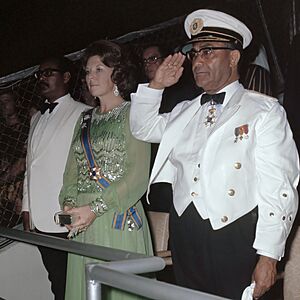
In 1973, the Dutch government began talks about independence with the local government of Suriname. This government was led by the NPS. Suriname officially became independent on November 25, 1975. The Dutch set up an aid program worth $1.5 billion to help Suriname until 1985.
The first President of independent Suriname was Johan Ferrier. Henck Arron, the leader of the NPS, became the Prime Minister. Even with agreements from the new government, about one-third of Suriname's population moved to the Netherlands before and after independence. They were worried that the new country might not be stable. Also, many Dutch settlers in Suriname had their land taken by the new Surinamese government, which went against earlier agreements.
In 1980, the government of Henck Arron was overthrown by a military coup. This was led by Sergeant-Major Dési Bouterse. President Ferrier did not accept the new military government. He appointed Henk Chin A Sen as Prime Minister. Five months later, another coup happened, and the army replaced Ferrier with Chin A Sen. Many people in Suriname initially welcomed these changes. They hoped the new army-led government would end corruption and improve their lives. However, the new government banned opposition parties and became more and more like a dictatorship.
The Dutch government at first accepted the new government. But relations between Suriname and the Netherlands broke down on December 8, 1982. On this day, 15 members of the political opposition were killed by the army at Fort Zeelandia. This event is known as the December murders. In protest, the Dutch and American governments stopped their aid to Suriname.
In 1985, the ban on opposition parties was lifted. Work began on creating a new constitution. The next year, a rebellion started in the interior of the country. It was led by Maroons who called themselves the Jungle Commando, led by Ronnie Brunswijk. The Bouterse government tried to stop the rebellion with violence, burning villages and other harsh methods. More than 10,000 Maroons fled to French Guiana and were recognized as refugees.
In 1987, Suriname adopted a new civilian constitution. The next year, Ramsewak Shankar was elected as president. However, he was removed in a military coup organized by Bouterse in 1990. In 1991, the opposition group, the New Front for Democracy and Development, won most seats in the parliamentary elections. Ronald Venetiaan was elected as the new president. The civil war ended after a peace agreement was signed in August 1992 between the government and the Surinamese Liberation Army (Jungle Commando), led by Ronnie Brunswijk.
In 1992, Jules Wijdenbosch, an ally of Bouterse, was elected as the new president. In 2000, Ronald Venetiaan became president again after winning early elections. In 2005, Venetiaan was re-elected, and his New Front coalition narrowly won the parliamentary election.
In July 2010, the parliament elected Bouterse as the new president. In 2015, his party, the National Democratic Party (NDP), narrowly won the parliamentary election. This gave Bouterse a second five-year term in power.
In 2020, the COVID-19 crisis began, and oil prices dropped. This led to an economic crisis. On May 25, 2020, a general election took place. The Progressive Reform Party (PRP) won 20 seats (an increase of 11), while the National Democratic Party (NDP) got 16 seats (a decrease of 10).
In July 2020, Chandrikapersad "Chan" Santokhi of the PRP was elected as the new President of Suriname. He replaced Bouterse. The PRP formed a government with the General Liberation and Development Party, led by former guerrilla leader Ronnie Brunswijk, who became the new vice president.
In February 2023, protests happened in the capital, Paramaribo, because of rising living costs. Protesters accused President Chan Santokhi's government of corruption. They stormed the National Assembly, demanding the government resign. However, the government condemned the protests.
See also
 In Spanish: Historia de Surinam para niños
In Spanish: Historia de Surinam para niños
- British colonization of the Americas
- Dutch colonization of the Americas
- French colonization of the Americas
- History of the Americas
- History of South America
- History of the Caribbean
- List of colonial heads of Suriname (Netherlands Guiana)
- List of presidents of Suriname
- List of prime ministers of Suriname
- Politics of Suriname
- Spanish colonization of the Americas
Images for kids


